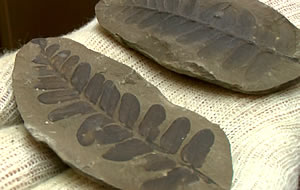Andrew, a volunteer at the Lapworth Museum, describes an example of Neuropteris heterophylla, a now-extinct species of seed fern that flourished during the Carboniferous period - his choice as Object of the Month from the Lapworth Museum of Geology.
Video transcript here
My name is Andrew Norris, and I am studying at the University of Birmingham for an MA degree in Antiquity, having already graduated from Birmingham with a BA in Archaeology. My studies, and my love of gardening, have helped to develop my interest in ancient plants, and through my voluntary work at the Lapworth Museum, I developed an interest in fossil plants like this one, and I am fascinated at how plants are preserved in archaeology and in geology and what they can tell us about the past.
 This fossil shows part of the Neuropteris heterophylla, a now-extinct species of seed fern that flourished during the Carboniferous period. This fossil was one of several found at the Deepfields colliery in the Black Country, and was sold in 1887 by the quarry foreman, William Woodall, for 12 old pennies to Sir Charles Holcroft (1831 – 1917), a Staffordshire industrialist and fossil collector, who left many of his fossils to the University of Birmingham on his death.
This fossil shows part of the Neuropteris heterophylla, a now-extinct species of seed fern that flourished during the Carboniferous period. This fossil was one of several found at the Deepfields colliery in the Black Country, and was sold in 1887 by the quarry foreman, William Woodall, for 12 old pennies to Sir Charles Holcroft (1831 – 1917), a Staffordshire industrialist and fossil collector, who left many of his fossils to the University of Birmingham on his death.
The fossil is unusual in the sense that the fine veins on the leaves survive well and appear very well detailed on the fossil. The remarkable detail has been achieved by the anaerobic conditions in which this piece of fern was deposited, and it is the lack of oxygen in a deposit that has also been helpful in the recovery of other ancient plant remains by wetland archaeologists. Together, the plants recovered from fossils and from wetland archaeology help to paint a picture of times that are, as once said by the pioneering archaeologist William Stukeley (1687 – 1765): “so old no books do reach them.”